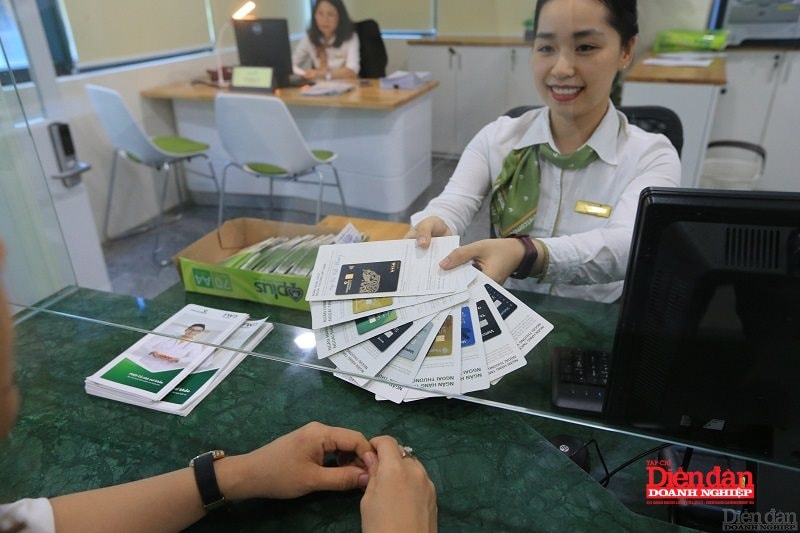Banking system liquidity remains stable, interest rates edge up
After two consecutive weeks of net withdrawals by the State Bank of Vietnam (SBV), system-wide liquidity remains stable, though interest rates in both markets have edged up slightly.

Although there are signs of a mild rebound, experts believe deposit rates will only increase slightly in the remaining months of the year. (Illustrative photo: Quoc Tuan)
During the week of October 6–10, the SBV increased the volume of open market operations (OMO) issuance to VND 49.3 trillion (17.4% WoW), expanding lending at the longer 28-day tenor while reducing the 7- and 14-day maturities. Meanwhile, OMO maturities rose to VND 69.2 trillion, resulting in a net withdrawal of VND 19.92 trillion. By the end of the week, the total outstanding OMO balance stood at VND 142.1 trillion.
This marked the second consecutive week that the SBV drained liquidity from the system, following a smaller net withdrawal of VND 6.9 trillion the previous week. The central bank also continued to sell six-month (180-day) USD forwards with a revocable clause at VND 26,550/USD, targeting banks with negative foreign exchange positions. This is the second time in just over a month that the SBV has intervened using this instrument, aiming to ease exchange rate pressures and support VND liquidity amid rising foreign currency demand toward the end of the quarter.
According to Yuanta Vietnam Securities’ monetary report, system liquidity has stabilized compared with the end of Q3, even as the SBV has continued to withdraw funds over the past two weeks. Interbank rates, however, climbed steadily from Monday to Thursday, with week-ending rates recorded at 4.38% (overnight), 5.39% (one week), 5.37% (two weeks), and 4.66% (one month)—an increase of 40 to 61 basis points (bps) across tenors.
In the interbank market, the recent trend of rising VND rates and falling USD rates has widened the overnight interest rate differential, with VND rates exceeding USD rates by 66 bps as of the end of last week.
“The recent upward trend in interbank VND rates has helped strengthen demand for holding VND on the money market, thereby supporting exchange rate stability,” said Nguyen The Minh of Yuanta Vietnam Securities.
Deposit rates on the retail market (market 1) have also inched up slightly at several banks. Average deposit rates for tenors from 2 to 36 months rose by roughly 0.22–1.06 percentage points compared with the previous week.
A number of commercial banks—including GPBank, BacA Bank, and Standard Chartered Vietnam—have raised deposit rates since early October. In addition, several banks, such as Vietcombank, MBBank, SeABank, Woori Bank (Vietnam), and Vikki Bank, are offering rate bonuses through promotional programs.
Earlier, in September, the money market saw system liquidity remain stable, with overnight interbank rates ranging between 3.8% and 4.6%, slightly lower than in August. The SBV continued to flexibly use open market tools, though OMO issuance volumes were lower than in the previous month.
Among retail deposits, the lowest rates continued to be offered by the “Big Four” state-owned banks—Vietcombank, Agribank, BIDV, and VietinBank—which maintained:
- 1–3-month terms: 1.6%–2.4% p.a.
- 6-month terms: 2.9%–3.5% p.a.
- 12-month terms: up to 4.7% p.a.
Large joint-stock commercial banks such as MB, Techcombank, VPBank, and ACB offered mid-range deposit rates:
- 1–3-month terms: 2.3%–3.6% p.a.
- 6-month terms: 3.5%–4.5% p.a.
- 12-month terms: 4.4%–5.0% p.a.
Medium- and small-sized commercial banks offered higher deposit rates:
- 1–3-month terms: 3.2%–4.35% p.a.
- 6-month terms: 3.8%–5.3% p.a.
- 12-month terms: up to 5.7% p.a. (including TPBank, OCB, MSB, BVBank, VietBank, Nam A Bank, PGBank, etc.
The highest deposit rates on the market were recorded as follows:
- 1-month: 4.15% p.a. (VCBNeo)
- 3-month: 4.35% p.a. (VCBNeo)
- 6-month: 5.3% p.a. (MBV, VCBNeo)
- 9-month: 5.4% p.a. (MBV)
- 12-month: 5.7% p.a. (MBV)
- These are all weak banks under compulsory transfer, now rebranded and pursuing digital banking transformation strategies.
Overall, the average deposit rate for 1–9-month terms at commercial banks rose by 3–16 bps at the end of September compared with the end of August. Meanwhile, the 12-month rate fell by around 9 bps, but 24–60-month rates increased by 8–30 bps.
“Although the SBV remains committed to its low-interest-rate policy and commercial banks have sought to diversify funding through bond issuance, maintaining low deposit rates is becoming increasingly difficult given the strong credit growth momentum,” said Nguyen The Minh.
As of end-September, credit had grown 13.4% year-to-date, while money supply rose 10.6% and deposits increased only 9.7%. “Therefore, a slight uptick in deposit rates at some banks since late September is understandable,” he added.
Experts generally expect deposit rates to rise only modestly toward year-end, while lending rates are likely to remain low to continue supporting economic growth.








